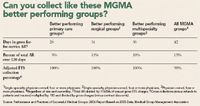Article
Collections: Learn from the pros
Author(s):
With effective billing and collection methods, you can rake in what you're owed in a month or less. Here's how.
If you think that aging buckets are what you find in a janitor's closet or a winery, you're probably not steeped in the science of billing and collection.

For Stoller's seven-doctor group, Chestnut Ridge Pediatric Associates, A/R over 120 days in 2005 was only 3 percent. That's because Chestnut Ridge quickly scoops up what it's owed. It typically collected from insurers and patients in 21 days, compared to 42 days for all MGMA groups. And the group is thorough as well as speedy-it collected almost 100 percent of its charges after insurance discounts were calculated, compared to the MGMA median of 98 percent.

Get a computer system that can track performance
Like other better performing practices, Chestnut Ridge Pediatric Associates conducts reconnaissance before a patient visit, collecting data so it can collect money later on. Every day, the billing staff verifies insurance eligibility and benefits for the next day's schedule of patients so they know whom to bill and what for. Their practice management software streamlines that job by automatically querying some of the group's largest payers. Staffers also run a separate report on any personal balances owed. That information primes front-desk personnel to ask patients to pay up when they show up, says Stoller.
The group's practice management system, installed in 2005, generates those patient balances more quickly and accurately than its predecessor did. "The old program was bad about tracking any changes in a patient's insurance, and the numbers didn't always come out right," says Stoller.
The new software also makes it a breeze to generate monthly report cards for physicians that put their E&M coding on a bell curve. Pediatricians, says Stoller, tend to undercode, and the report cards reveal when they routinely record a 99213 for an established-patient office visit when a higher-paying 99214 might be warranted. Such summaries were so difficult to generate with the old software that they were issued only twice a year.
Good reports are key to monitoring the performance of your billing and collection machine, but many physicians use antiquated practice management systems that can't spit out the needed numbers, says healthcare computer consultant Rosemarie Nelson in Syracuse, NY. "Some can't even produce an aged A/R report-A/R in buckets of zero to 30 days, 31 to 60 days, etc-by individual payer, which helps pinpoint systemic problems," says Nelson.





